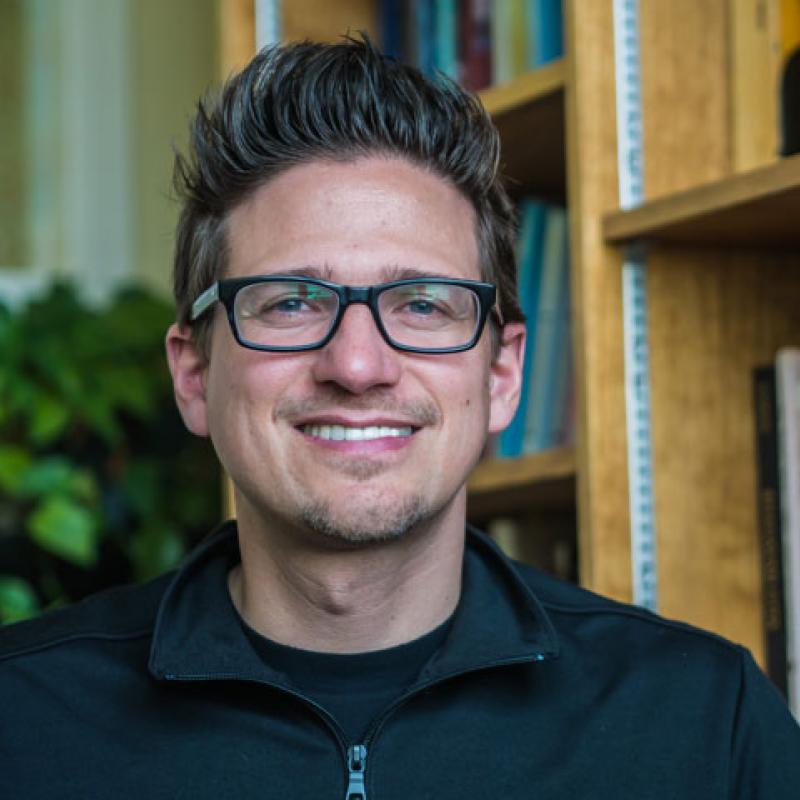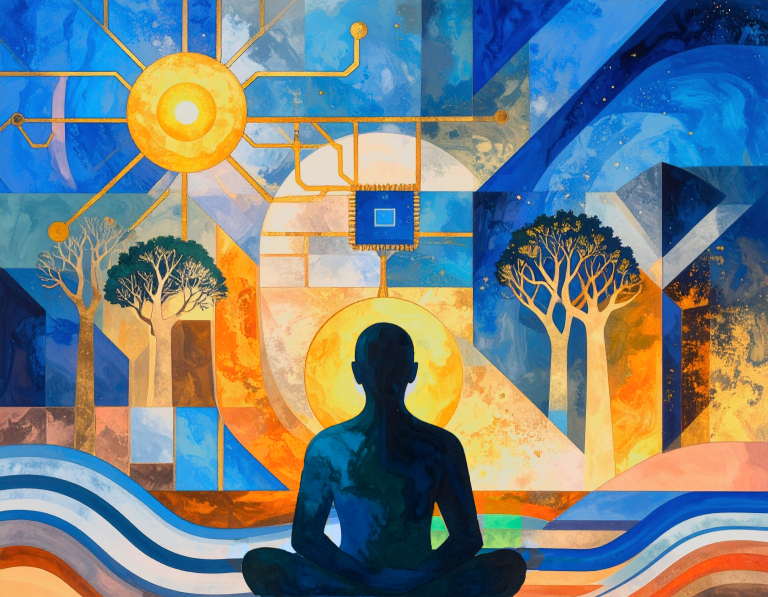JCS: How do you bring yogic traditions and psychedelic science together? What brought you to this point?
SS: There are a number of different factors. Part of it came out of my own experiments with contemplative practices and with psychedelics, which, among other things, had played a part in my interest in the study of both philosophy and religious experiences of all sorts and different types. So in terms of my formal academic work, a big part of the connection happened very early on in my career when I developed an interest in the study of religious experience and mysticism. I served on the mysticism unit for the American Academy of Religion (AAR) for a number of years and was interested in a wide range of different types of religious experiences—the more philosophical side of what claims can be made on the basis of religious experience. And a part of that was always connected on some level to this question: What is the relationship between the types of experiences that arise out of the use of psychedelics and more endogenously derived types of religious experiences? On some level, I’ve always been interested in this dynamic between the catalytic function of certain psychedelic substances, which are opposed to the ways people cultivate extraordinary states of mind or body through things like ascetic discipline, whether it’s fasting or formal disciplines of mind and body like yoga. So that’s the bigger umbrella. My current project, though, really came out of writing this larger book on the history and philosophy of yoga called Tracing the Path of Yoga: The History and Philosophy of Indian Mind-Body Discipline. And as I went through that material, I kept having this thought that at each stage of the process, someone should look more deeply into the role that psychoactive substances have had in these various eras of yoga’s development. That planted a seed in my mind that these are things that maybe need to be looked at more deeply. In addition to that, for about three years I was part of a religion and technology seminar that was funded by the Luce Foundation and hosted at the Institute for Buddhist Studies at the Graduate Theological Union in Berkeley. And part of that project was looking at the ways in which contemporary biohackers and transhumanists are utilizing what I called contemplative technologies as a means to enhance performance, and to some extent for the purpose of personal or spiritual exploration. And so I ended up at a conference called the Awakened Futures Summit. Particularly, I was there primarily thinking about some of the neurotechnologies that were being discussed, which included things like magnetic and ultrasound stimulation of the brain as a way to try to cause people to have meditative or other sorts of contemplative experiences. But the buzz really was around psychedelics—both microdosing (a major part of that sort of biohacker culture) and also the idea of taking higher doses to develop insight, to develop creativity. It oriented me to the import of those, the use of psychedelics within the technologist community, but also attuned me to the kind of rising wave of the psychedelic renaissance. I ended up getting interested in the ways in which psychedelics were becoming increasingly mainstreamed in terms of the scientific research and then within the popular public space. That interest dovetails with my more historical interests in the relationship between yoga and psychoactive substances. What I found myself doing is going back and forth between looking at the way technologies, but also modern yoga or transnational yoga communities, were embracing psychedelics while digging more deeply into the historical and philosophical materials to learn what exactly can we say about the use of psychoactives or psychedelics within the historical context in its relationship to yoga.
What is the relationship between the types of experiences that arise out of the use of psychedelics and more endogenously derived types of religious experiences?
JCS: I’m so curious—what kind of impact are you seeking to have or do you think or hope this will have on either of those works or communities, or their combination?
SS: One way I would respond to that is to say, a relationship that’s been really fruitful for me has been the relationship between my own sort of contemplative practice, postural yoga, mindfulness, and other meditative practices, and both the historical and the more anthropological research I’ve done. I can’t tell you how many times I’ve been practicing with the yoga community and observed something that just gave me an acute, very clear insight into the academic work that I’m doing. And of course, the reverse of that is the academic knowledge has suited me well in terms of entering into either spaces related to yoga or meditation and feel like I know my way around to some extent. One thing I learned through that process, especially when working with modern yoga communities, is that I have to kind of attune myself to the fact I’m not in an academic context. I’m in a practitioner context, where a kind of different mode of operations is at work. Interestingly enough, that’s played out in a kind of similar way in terms of my research on psychedelics and so whether that’s being around biohackers and just trying to listen deeply and pay attention to the way in which biohackers are integrating these things into their lives, but also things like the social dynamics involved in these communities. As part of my research, again, playing on that kind of scholar-practitioner dynamic, I actually have been trained as a psychedelic facilitator, a psilocybin facilitator, through the first legal facilitator training program in Oregon called InnerTrek. I found that it was in some respects quite similar to entering into these yoga communities where I have a lot of academic knowledge that I’m bringing into this conversation, but this is not an academic space—it’s a practitioner space. There were so many times where being in that practitioner space shed light on the more historical piece or philosophical piece of my studies of psychedelics, and vice versa. I had a literacy about psychedelics that was really helpful and useful to bring into that psychedelic training space. And, in both cases, whether we’re talking about going with these yoga communities or the psychedelic communities, as much as I had already academic knowledge, it was always challenged. There are always things that I learned about the kind of real-world practice that challenged, or at least changed, the way I thought about my academic work. And of course, communities where yoga and psychedelics are practiced together, those, again, are both of those worlds all together as one.
JCS: Both sides.
SS: It’s really both sides. I wrote my book Tracing the Path of Yoga in part with the thought that this would be a service to people in the academic community who would like some sort of coherent narrative for thinking about the historical arc of yoga. And that came out of, in part, my own frustration in teaching a course on the history of philosophy of yoga, and feeling like I had to cobble together all of these different pieces that didn’t quite fit together. I wanted to write a concise narrative that had some degree of comprehensiveness so that you can weave a coherent narrative. This serves an academic community, but at the same time, I would like to think practitioners who have enough of an interest can go to that material and get a historical and philosophical orientation—and even perhaps steer clear of some of the fault lines within modern transnational communities that people can encounter if they don’t really have a critical or historical perspective on the larger tradition. And so what I’d like to do ultimately is something similar in terms of this connection between yoga and psychedelics—offer an academically informed perspective that’s respectful for practitioners. But at the same time, provide a kind of orientation, whether you’re a scholar or a practitioner, that is going to be useful either on the theory or the practice. That’s my dream.
JCS: That gets me to this next question, and maybe part of the answer is bridging together scholars and practitioners and giving them both new insights: scholars, into the lived tradition of yoga and the lived experience of that, and practitioners into a historical account of it. What are your views of the synergies? What other synergies are you finding?
…communities where yoga and psychedelics are practiced together, those, again, are both of those worlds all together as one.
SS: If you know and understand the theory and practice, say, of certain forms of meditation, I would argue they orient you in a way to see a psychedelic journey that can be quite useful. And of course, some of the contemporary research, like Griffiths’ and others, has looked specifically at how experienced meditators fare in a psychedelic space. Do they develop additional personal insight, or are there social markers following that journey that seem amplified? Griffith seemed to believe his data said yes, that meditators have a bit of a leg up in terms of those psychedelic spaces. There’s that sort of integration there that can be really useful. I’ve talked with practitioners who said that their practices of a particular type of Buddhist meditation, for example, oriented them toward some of the non-ordinary forms of awareness they experienced in a deep-absorption type of meditation. And thus, they felt more comfortable and not necessarily surprised in the way that some of their peers were, when they encountered these types of things. I’ve heard the argument before, that part of the appeal, for example, to psychedelics to Buddhists is that it perhaps compensates for the ways in which contemporary Buddhist meditation often leaned heavily toward the insight end of the spectrum, and hasn’t really focused as much as premodern traditions did on more ecstatic and absorbed focus modes of practice, whether that’s something like shamatha meditation, developing deep concentration, or some of the forms of tantric practice and especially visualization. So those are some of the clear larger intersections. You also have the idea of yogic and meditative practices as accessories to psychedelic practice or, in some cases, psychedelic facilitation. Janis Phelps’s work, for example, talks about the importance of psychedelic guides or facilitators having experience in complementary techniques: things like mindfulness, or some degree of breath awareness or breath control, and an ability to hold a psychedelic space with a certain degree of poise, using those practices. A facilitator isn’t teaching anyone yoga or guiding yoga practice during a session. Typically, they’re nondirective kinds approaches. Nonetheless, it may be that someone could use some training in mindfulness, or other forms of meditation or yoga, as a preparation so that they’re able to manage themselves in that psychedelic space better. Or alternately, when it comes to the integration phase, maybe that psychedelic journey indicated that there were certain things that could be worked on through specific approaches. So there’s a way in which contemplative practices become tools for the psychedelic journey.
JCS: Where do you see, or where do you hope to see, this intersection going? I think you’ve laid out some beautiful ways that are tangible now, or that are beginning to become not necessarily institutionalized, but leaned into with the facilitation program, for instance. But where do you hope to see this intersection going either for your own work, or just at large as people are bringing together understandings of psychedelic experiences and contemplative practice?
SS: There’s so much to be said about that. It is really unfortunate that many of these psychedelic substances or plant medicines were so demonized and put in such a kind of state of legal limbo, because one can only imagine if research had been going on since the early 1970s when the Controlled Substances Act was passed, we would probably understand the way that the brain works and probably have whole families of medical interventions based upon that research that would add to the very limited toolbox that contemporary psychiatry has for dealing with mental health problems in particular. I would like to see a legal and cautious approach proceed that allows us to make those steps forward. I would like to see, as we’ve seen in Oregon, the development of regulatory systems that seek to make psychedelic use in either a therapeutic or an enhancement sort of context accessible within the realm of safe evaluation. One of the things that the Oregon program really has going for it is a kind of baseline standard for facilitators, a process for cultivating the psychedelic mushrooms and evaluating their potencies, so there’s no surprises there. And, more broadly, there’s a kind of sentiment that if we do this the right way, people will benefit from it and we’ll mitigate the risks. A big part of the Oregon model is acknowledging that there are risks and being very clear and communicating those things. I would also like to see perhaps more attention to the larger social and economic impacts of things like psychedelic tourism, which can be very extractive, and also consciousness and reflection on the dangers of appropriation and commodification of psychedelics. Again, there’s some real comparisons to be made with yoga, where issues of appropriation, of commodification, questions of what is authentic, who is authoritative—these play out in all sorts of similar ways within the psychedelic spaces. One of the things that I can do that adds value to these conversations is bring some of the knowledge I have about the way that those things play out in the context of yoga into the psychedelic space. And obviously when you have yoga and psychedelics together, there’s a kind of alchemy there, for me personally, in terms of applying that knowledge.
JCS: That’s a really wonderful vision.
SS: Well, thank you. I appreciate it.
JCS: It’s a holistic way of holding up the space and how they come together. Last question—what are some resources that our readers can use to help think about this intersection and about this work?
SS: One part of this is perhaps the Journal of Contemplative Studies! But along with that, I think we’re going to see really an emerging body of scholarship around these issues. In fact, there was recently a set of sessions at AAR looking at psychedelics in a global world religions context. A historian at the University of Saskatchewan, Erica Dyck, has been doing great work, providing a larger historical framework for thinking about the larger history of psychedelics and then particularly this kind of critical era between the mid-20th century to the present. In fact, she just came out with an edited volume that incorporates people who are coming from a variety of disciplinary perspectives and a variety of different regional areas of focus. And there’s a larger canon, including Gordon Wasson and to some extent contemporary scholars and authors like Brian Muraresku whose work has been among those at the forefront of really bringing these conversations into popular awareness—as well as Michael Pollan’s work, which similarly brought psychedelics down to earth for a greater sort of larger audience.
JCS: That’s all so wonderful, thanks so much for sitting down with us, Stuart. We really appreciate this conversation.
SS: Thank you!






